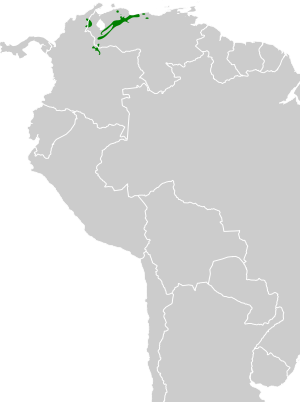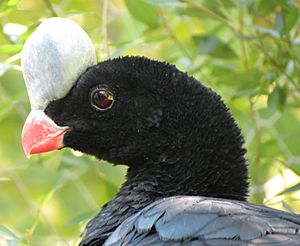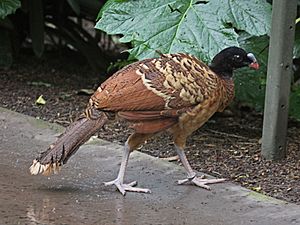Helmeted curassow facts for kids
Quick facts for kids Helmeted curassow |
|
|---|---|
 |
|
| Northern helmeted curassow, Pauxi pauxi |
|
| Conservation status | |
| Scientific classification | |
| Genus: |
Pauxi
|
| Species: |
pauxi
|
| Subspecies | |
|
Pauxi pauxi gilliardi Wetmore & Phelps, 1943 |
|
 |
|
| Synonyms | |
|
Crax pauxi Linnaeus, 1766 |
|

The helmeted curassow (Pauxi pauxi), also known as the northern helmeted curassow, is a large bird that lives on the ground. It belongs to the family Cracidae, which includes other curassows, guans, and chachalacas. You can find this bird in the warm, wet cloud-forests of western Venezuela and northern Colombia.
There are two types, or subspecies, of helmeted curassows. They live in different mountain ranges. This bird is mostly black with a white tip on its tail. It has a red beak and a special grey "helmet" on its forehead. Sadly, the number of these birds is going down. Because of this, the International Union for Conservation of Nature says it is an "endangered" animal.
Contents
What Does It Look Like?
The helmeted curassow is a big, black bird that lives on the ground. It has a small head and a large, bluish-grey "casque" on its forehead. This casque looks a bit like a helmet. The bird also has a red beak and white tips on its tail feathers. Its back and chest feathers have a shiny green look. Its belly is white.
Both male and female helmeted curassows look very similar. Adult birds can be about 80 to 100 centimeters (31 to 39 inches) long. Males are usually bigger, weighing about 3.6 kilograms (8 pounds). Females are a bit smaller, weighing around 2.6 kilograms (5.8 pounds).
Sometimes, a rare female might have black stripes and reddish-brown feathers. For a while, another bird called the horned curassow was thought to be a type of helmeted curassow. But now, scientists know it is a separate species.
Where Do They Live?
The helmeted curassow is one of the largest birds in its home. It lives in the eastern Andes mountains of Venezuela and Colombia. A recent study in Tamá National Natural Park in Colombia found many helmeted curassows there. About 4.8 birds were found in every square kilometer.
The study also showed that most of these birds stay close to the ground. They live on the forest floor or just below the main tree branches. This makes them easy targets for poachers during the dry season. Poachers are people who hunt animals illegally.
The helmeted curassow eats mostly seeds, fruits, insects, and small animals. The female bird lays two cream-colored eggs. She sits on them for about 30 days until they hatch.
Why Are They Endangered?
The helmeted curassow is listed in Appendix II of CITES. CITES is an international agreement that helps control the trade of wild animals and plants. This listing means that trading these birds must be carefully watched.
Before, the IUCN (International Union for Conservation of Nature) said the helmeted curassow was a "vulnerable" species. This meant it was at risk. But new studies show that its numbers are going down much faster. Because of this, in 2008, its status was changed to "Endangered". This means it is at a very high risk of disappearing forever.
Different Types of Helmeted Curassows
There are two main types, or subspecies, of the helmeted curassow:
- Mérida helmeted curassow (Pauxi pauxi pauxi)
- This type lives in the Cordillera de Mérida mountains and into the Cordillera Oriental, Colombia.
- Its casque, or "helmet," is larger and shaped like an egg.
- Perijá helmeted curassow (Pauxi pauxi gilliardi)
- This type lives in the Serranía del Perijá mountains.
- Its casque is smaller and less round, looking more like a cylinder.
Scientists are still learning about how these birds evolved. It is thought that helmeted curassows first appeared about 8 to 7 million years ago. Their current homes suggest they became separated about 6 million years ago. This happened as their mountain ranges slowly rose up.
See also
 In Spanish: Paujil copete de piedra para niños
In Spanish: Paujil copete de piedra para niños



